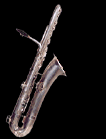|
Hüttl section subnavigation
The Hammerschmidt Company
German-made Hüttl saxophones, the mystery finally solved!
Since fall of 2004, when I stumbled upon and bought a mysterious German-made alto sax with the brand Hüttl, the history of this little horn has intrigued me. I had posted queries to Sax on the Web, emailed Pete Hales, who at the time owned the Vintage Saxophone Gallery, and posted a dedicated page to the Hüttl on this site in the hopes that someone would find it, and write to me.
Over the years, I have received a number of emails with some information, but nothing really concrete: that is, until April 2008. Nearly 3 ½ years since I bought my Hüttl sax, I received emails from two men in Germany. The first man to contact me was Dave Denton. He is a saxophone player who owns a Hammerschmidt tenor. The second man, Uwe Ladwig, is the repair technician who restored Dave’s Hammerschmidt.
Through the information provided by both of these men, I’ve been able to put together the history of the German-made Hüttl saxophones. What follows below is the history I have combined from Dave and Uwe.
Apparently the German instrument company Hüttl had a reputation for being a top music firm, and delivered to lots of orchestras and schools, so they ordered instruments from various well-known makers and sold them on with their own logo usually engraved on the bell (a practice known as “stencilling”).
My alto saxophone is a stencil made for Hüttl by Karl Hammerschmidt in Burgau, in what was then West Germany. Hammerschmidt sold their saxophones under the trademark name of “Klingsor”, and only made altos and tenors. The Klingsor sopranos and baritones were actually stencils for Hammerschmidt made by J. Keilwerth. (Just an interesting side note, Hammerschmidt made horns for Great Britain and Japan named "La Fleur" and "La Fleur Deluxe".)
Hammerschmidt saxophones are hard to find these days, especially the top of the line models like the one I have. Dave explained that the Hammerschmidt instruments are sought after by collectors, and are really quite rare.
Dave Denton says the following about the history of the Hammerschmidt saxophones:
Martin Hammerschmidt started producing clarinets in 1873 in Egerland (now part of the Czech Republic) until 1910 when his son Karl took control of the company. Later, in 1934, Karl's 6 sons, all of whom were instrument makers, carried on until the end of the war when they were forced to return to Germany. Here they re-established the company and between approximately 1950 and 1980 also produced alto and tenor saxophones. The first instruments were much influenced by the Buescher and Conn models of the time, but later the lower keys were transferred to the right side of the bell and clear plastic protectors were added, similar to the 1950's style made popular by Keilwerth and the Conn Constellation. Some models were made with metal key protectors, and I suspect these were also used on the stencil ranges (Hüttl) to make their origins less obvious.
As the influence of cheap imports from the Far East made their mark on European musical instrument production, the Hammerschmidt company tried to reduce costs by simplifying their designs and by eliminating lots of expensive details. But in 1982, the production of saxophones eventually came to an end with an estimated 5,000 instruments completed.
Some of the instruments were covered with mother of pearl insets, on the palm keys, the G-sharp chaos, low E-flat/C, all the trill keys including the rarely seen top E-flat trill, the low E-flat and G-sharp trills and the octave key system. There were also engraving details over the whole instrument and on the bell was a picture of a blacksmith banging on an anvil with a hammer and notes flying through the air. The instruments were solidly made, heavy and coupled with accurate rolled tone holes, and gave a fat but edgy sound.
The action makes the Hammerschmidt very playable and even today seems surprisingly light and positive - it also looks fantastic!
When Dave got his saxophone, he knew nothing about the Hammerschmidt brand, and even though he is in Germany, finding information was quite difficult. However, he did eventually get in touch with the company, which only produces clarinets now, and they were able to tell him that that his horn was made in 1957.
Now there is still a wee bit of a mystery left however. In 2005, I saw an English-made tenor that appeared on eBay . What is its story? Maybe the new owner will figure that one out!
Back to the top.
|























